Electric Cooperative Timeline
Santee Cooper & Colleton Solar Farm
In December of 2013, the state's largest solar farm, the Colleton Solar Farm, opened. The 3-megawatt facility produces electricity that is transmitted to Santee Cooper for use by the state's electric cooperatives.
Honor Flights of World War II
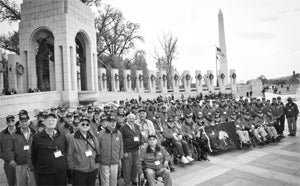
Electric cooperatives were the sole sponsors of two Honor Flights of World War II veterans to Washington, D.C., in 2012 to visit the national memorial constructed in their honor. Through their magazine, South Carolina Living, co-ops appealed to more than one million readers, hoping to find 100 vets to take the trip. In April and September, 185 made the trip. A 212-page book of amazing stories and photographs tells their stories.
The book is available online.
S.C. co-ops and Duke Energy
CFL Bulbs
Conservation Practices
Renewable Energy
2000 to present
As part of the agreement, Santee Cooper power was dispatched for the first time to Saluda River member cooperatives beginning January 1, 2001. Santee Cooper power now was delivered to all South Carolina cooperatives.
Electric cooperatives had long been recognized as catalysts of economic development. Findings in 2003 confirmed that more than 300 industries on cooperative lines employed approximately 30,000 residents.
In 2004, S.C. state law was changed to allow municipalities to choose cooperatives as service providers
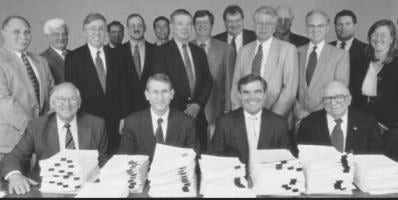
1990 to 1999
The Rural Utilities Service assumed functions of the REA in 1994.
The year 1998 marked the response by electric cooperatives to proposed deregulation of the electric utility industry. Cooperatives began urging lawmakers to take a cautious approach to deregulation.
The same year saw the launch of Touchstone Energy, the national brand for electric cooperatives. More than 750 cooperatives share the Touchstone Energy brand to help tell the cooperative story of integrity, accountability, innovation and commitment to their communities.
New Horizon Electric Cooperative started providing transmission service to Saluda River member cooperatives in June 1998.
On what would prove to be a red-letter day, leaders of all 20 S.C. electric cooperatives gathered in Washington, D.C. with officials from the Rural Utilities Service on May 6, 1999. That day, they signed an agreement to strengthen cooperatives and hold down power costs by admitting Saluda River into the membership of Central.
1980 to 1989
In 1980, electric cooperatives and Santee Cooper signed a long-term power supply agreement, which also specified how the two power systems were coordinated and integrated.
Women Involved in Rural Electrification (WIRE) began in 1982 as the charitable arm of many electric cooperatives, which assists disaster victims, homeless shelters, children’s homes, and a host of community programs.
The Duke Power-operated Catawba Nuclear Station began commercial operation in 1985, with Saluda River Electric Cooperative owning 18.8 percent of Unit 1.
Heightened challenges to electric cooperatives arrived in 1986 when the Reagan Administration proposed to sell-off Power Marketing Administrations such as Southeastern, but Congress prohibited the sell-off.
In 1988, Central’s economic development department joined with a similar department at Santee Cooper to form the Palmetto Economic Development Corporation, which provides economic development support to all electric cooperatives.
Hurricane Hugo ripped through South Carolina in September 1989. More than 3,000 cooperative employees from other states rebuilt over 11,000 miles of power lines.
Palmetto Electric Cooperative launched Operation Round Up in 1989 to let cooperative members to round up their bill payments and help fund local relief projects. Hundreds of cooperatives across the country went on to follow the example.
1960 to 1969
By 1961, electric cooperative leaders recognized that they should identify their co-ops as co-ops and not as the REA. Building signs bearing a streak of lightning and the letters REA were taken down.
In 1965, the Dolphus M. Grainger Steam Generating Electric Plant, financed and constructed by Central, went on line in Conway under the operation of Santee Cooper.
Marion Electric Cooperative merged into Pee Dee Electric Cooperative on December 8, 1965.
1970 to 1979
In what amounted to a repeal of the Rural Electrification Act, President Nixon on January 3, 1973 ordered a halt on 2 percent direct loans to electric cooperatives. The loan program was re-established in March 1973.
The Arab oil embargo of June 1973 marked the beginning of the nation’s first energy crisis and the end of cheap energy in the United States.
On August 1, 1973, Salkahatchie Electric Cooperative merged into Edisto Electric Cooperative.
Cooperative Electric Energy Utility Supply (CEE-US) was founded in 1975 to provide service to cooperatives through bulk purchase of materials and equipment.
1950 to 1959
The Southeastern Power Administration was created in 1950. Headquartered in Elberton, Georgia, Southeastern markets power generated at reservoirs to electric cooperatives and other utilities in South Carolina and other states.
In 1950, electric cooperatives decided to keep critical infrastructure resources in South Carolina by officially partnering with Santee Cooper. Santee Cooper sold power at one-third of the cost of the power sold by investor-owned utilities.
Santee Cooper power was first delivered over the transmission lines built by Central in 1952.
The Southeastern Power Administration in 1953 began marketing hydropower from Thurmond (formerly Clark’s Hill) Dam, first of three hydropower projects on the Savannah River.
Central had built 1,000 miles of transmission lines by the end of 1954. Today, the network--mostly cooperative built--consists of more than 4,400 miles of transmission lines.
In 1957, electric cooperatives established the Washington Youth Tour, bringing thousands of high school youths to the nation’s capital each year to learn about the democratic form of government and its importance to cooperatives.
Saluda River Electric Cooperative, a generation-and-transmission cooperative, was formed in November 1958 by five distribution cooperatives in the Upstate to represent them in wholesale power dealings.

1940 to 1949
Fairfield Electric Cooperative, on January 20, 1940, became the third cooperative to serve members.
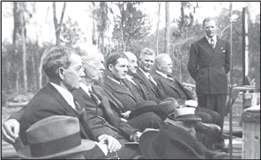
During 1940, 11 cooperatives were born. Nine were formed in the first six months. On January 5, 1940, Berkeley Electric Cooperative was incorporated, and a month later, on February 5, 1940, Black River Electric received its charter. On February 13, 1940, Coastal Electric Cooperative was incorporated. Then, on March 6, 1940, Pee Dee Electric Cooperative energized its first line, followed by Lynches River Electric Cooperative, which began providing service on March 15, 1940.
On April 25, 1940, Horry Electric Cooperative was incorporated, as was Broad River Electric Cooperative on June 10, 1940. Later that week, on June 14, 1940, Tri-County Electric Cooperative received its charter. Then, Newberry Electric Cooperative was incorporated on June 17, 1940.
Little River Electric Cooperative received its charter June 19, 1940, the same day that Edisto Electric Cooperative energized its first line. The next day, on June 20, 1940, Mid-Carolina Electric Cooperative was incorporated—the same day that Santee Electric Cooperative began providing service.
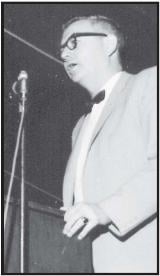
Palmetto Electric Cooperative received its charter on August 8, 1940, shortly before Blue Ridge Electric Cooperative was incorporated on August 14, 1940.
Marlboro Electric Cooperative energized its first line on September 3, 1940. Black River Electric Cooperative followed suit on December 20, 1940.
Seven electric cooperatives all began service on the same day in 1941. Blue Ridge Electric Cooperative, Coastal Electric Cooperative, Horry electric Cooperative Little River Electric Cooperative, Newberry Electric Cooperative, Mid-Carolina Electric Cooperative and Tri-County Electric Cooperative all began serving members on January 7, 1941.
On March 12, 1941, York Electric Cooperative was incorporated.
Palmetto Electric Cooperative energized its first line October 1, 1941, as did Broad River Electric Cooperative on October 7, 1941, and York Electric Cooperative, on October 10, 1941.
Two electric cooperatives, Salkehatchie and Marion, incorporated and energized lines during the same period but later merged with other cooperatives.
By 1941, electric cooperatives were beginning to defend themselves against strong attacks. Investor-owned utilities sought to persuade the public to believe that electric cooperatives were out of step with American free enterprise. Ironically, many people later would consider cooperatives as shining examples of the free enterprise system.
The electric cooperatives in South Carolina faced the same challenges as their more than 900 counterparts in other states. These challenges, as well as wartime labor and material shortages, galvanized electric cooperative leaders to unify and organize state associations.
The same unity exists in The Electric Cooperatives of South Carolina, Inc., the electric cooperatives' state association, formed July 8, 1941. The association provides a variety of services in addition to Living in South Carolina Magazine, the voice of South Carolina's electric cooperative members.
On February 17, 1942, Santee Cooper generated power for the first time.
Electric cooperatives in coastal and central portions of the state formed a generation-and-transmission cooperative to pool their buying power and purchase and transmit wholesale power. Central Electric Power Cooperative was born in 1948.
Central received its first federal loan for approximately $7.5 million in 1949 to build transmission lines connecting cooperatives to Santee Cooper sources of generation.
1934 to 1939
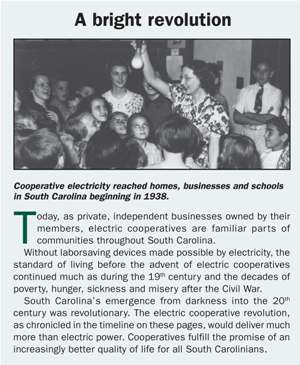
Santee Cooper, the moniker for South Carolina Public Service Authority, has been a key player in the electric cooperative revolution. As the major power supplier to, and partner with, electric cooperatives, Santee Cooper is the state owned electric and water utility established on April 7, 1934.
Electrification was one of President Franklin D. Roosevelt’s relief projects announced January 4, 1935, to help the nation recover from the Great Depression. The following April, Congress apportioned $100 million for the project, and the next month, Executive Order 7037 created the Rural Electrification Administration (REA).
At the request of Governor Olin D. Johnston, who had met with President Roosevelt, the South Carolina General Assembly in 1935 created the short-lived State Rural Electrification Authority. The agency’s mission was to extend lines from existing power companies to rural areas. The authority was shut down six years later, amid criticisms of overcharging consumers and limiting service.
South Carolinians knew they could get lights only by securing them on their own. They took the relief project into their own hands. The electric cooperative revolution was born.
County agents from Clemson Cooperative Extension Service were instrumental in telling consumers how to form and run their own not-for-profit electric cooperatives.
Seeds of the first electric cooperative in South Carolina sprouted during 1937, when people in Aiken County began meeting to learn how to get lights in their homes.
On February 15, 1938, Aiken Electric Cooperative became the first cooperative in South Carolina to receive its charter. The cooperative energized its first line on November 8, 1938 to begin providing electric service.
Governor Johnston signed the South Carolina Rural Electric Cooperative Act, 1939 (41) 240, Title No. 173, into law on May 4, 1939.
Seven new electric cooperatives were incorporated during 1939. Four of them were born in May and June of 1939: Laurens Electric Cooperative was incorporated May 12, 1939; Lynches River Electric Cooperative received its charter May 22, 1939; On June 9, 1939, Fairfield Electric Cooperative received its charter; and Edisto Electric cooperative was chartered on June 12, 1939.

Three more cooperatives saw their beginnings during December 1939: On December 14, 1939, Santee Electric Cooperative was incorporated. Marlboro Electric Cooperative was chartered on December 15, 1939; On December 18, 1939, Pee Dee Electric Cooperative received its charter.
On December 19, 1939, Laurens Electric Cooperative became the second cooperative in South Carolina to energize its first line.
